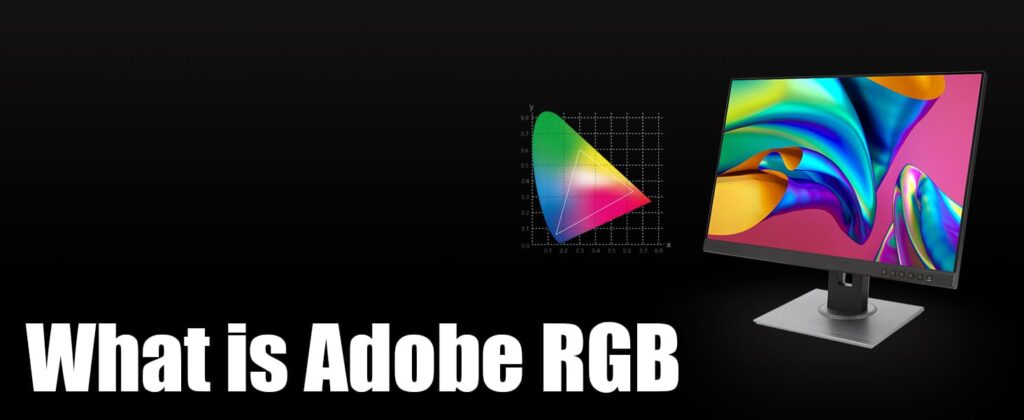We’ve all heard of Adobe RGB. It’s a very popular tool for photography. Created by Adobe in 1998 this color space is designed to better replicate the colors that can be achieved on CMYK printers using RGB primaries.

Why is this important for monitors? Most displays today use sRGB, which is green and blue. Adobe RGB monitors, on the other hand, boast a wider range of colors. I’ve written an in depth article about sRGB, so read on to learn more.
Adobe RGB Monitors vs. sRGB Monitors
While sRGB monitors are used on a daily basis, Adobe RGB monitors are chosen by the most experienced.

In the table below this text, you can see a comparison of these two monitors by their features.
| Feature | sRGB Monitors | Adobe RGB Monitors |
|---|---|---|
| Color Gamut | Covers ~35% of visible colors | Covers ~50% of visible colors |
| Best Use Cases | Web design, casual use | Photography, printing, editing |
| Price Range | Affordable | Premium, higher-end |
Adobe RGB monitors are great for displaying realistic colors, so they are used by people who do things like printing, so they know what they do on screen will be the same color on paper. I think most people now understand what these monitors are intended for.
Key Features to Look for in Adobe RGB Monitors
- Wide Gamut Support: Look for a monitor that covers at least 99% of the Adobe RGB spectrum for maximum accuracy.
- 10-bit panel: This type of panel is capable of displaying images in 1.07 billion colors.
- IPS Panel Technology: These panels have excellent colors compared to TN or VA panels. I wrote an article about this, so read it.
- Factory Calibration: Monitors with built-in calibration save you time.
- HDR Support: High Dynamic Range HDR describes a type of photography that captures a dynamic range that cannot be achieved in a single photo.
Top Adobe RGB Monitors for Creative Professionals
In the table below, I’ve listed a few monitors that can offer at least 99% Adobe RGB Coverage.
| Monitor | Adobe RGB Coverage | Key Features |
|---|---|---|
| Eizo ColorEdge CG319X | 99% | 4K resolution, built-in calibration |
| BenQ PD3220U | 95% | 32″, HDR10, excellent factory calibration |
| Dell UltraSharp UP3221Q | 99.9% | 4K HDR, backlit mini-LED zones |
| ASUS ProArt PA32UCX | 99% | HDR, excellent color depth |
Why Use Adobe RGB Monitors?
The strength of Adobe RGB monitors is in showing colors accurately. For photographers this means landscapes stay bright and green, and skies keep their soft shades of blue.

Without an Adobe RGB monitor, important details can be missed. In sRGB, some colors are missing, leading to blurry or inaccurate hues.
Calibration: Key to Using Adobe RGB
Tools for Calibration:
- i1Display Pro: The ultimate calibration tool for photographers.
- SpyderX Elite: User friendly and great for general creative work.
- Built-in Calibrators: Some monitors like the Eizo ColorEdge series, feature built-in calibration sensors.
Who Needs Adobe RGB Monitors?
Wondering if an Adobe RGB monitor is right for you? Here are a few examples:
- Photographers: Editing RAW photos is easier with a wider color gamut.
- Graphic Designers: Accurate colors are crucial when preparing designs for print.
- Video Editors: Adobe RGB ensures color grading looks consistent across various mediums.
If your work is mostly online or web-based, a good sRGB monitor might be enough.
Adobe RGB Gaming Monitors: Are They Worth It?
We’re used to gaming on sRGB monitors, while some gamers prefer Adobe RGB monitors for their improved color richness.

If you’re not a gamer who edits photos in your spare time the extra cost may not be worth it. 100% sRGB is still the best for gaming and has a great price point.
Conclusion
Adobe RGB is in my humble opinion, only for professional photographers or designers. Buying a monitor like this for work is justified if you really need it, they cost a lot. But if you are a gamer, I would not recommend you to look at the prices of such monitors for which you can buy a complete gaming setup.
FAQs
What is an Adobe RGB monitor used for?
An Adobe RGB monitor is mostly used for tasks like professional photo editing.
What are the best Adobe RGB monitors under $1,000?
Check out monitors like the BenQ PD3220U and ASUS ProArt series that offer excellent Adobe RGB.
How do I switch my monitor to Adobe RGB?
Go to your monitor’s settings or use the software provided by the manufacturer to enable Adobe RGB mode.